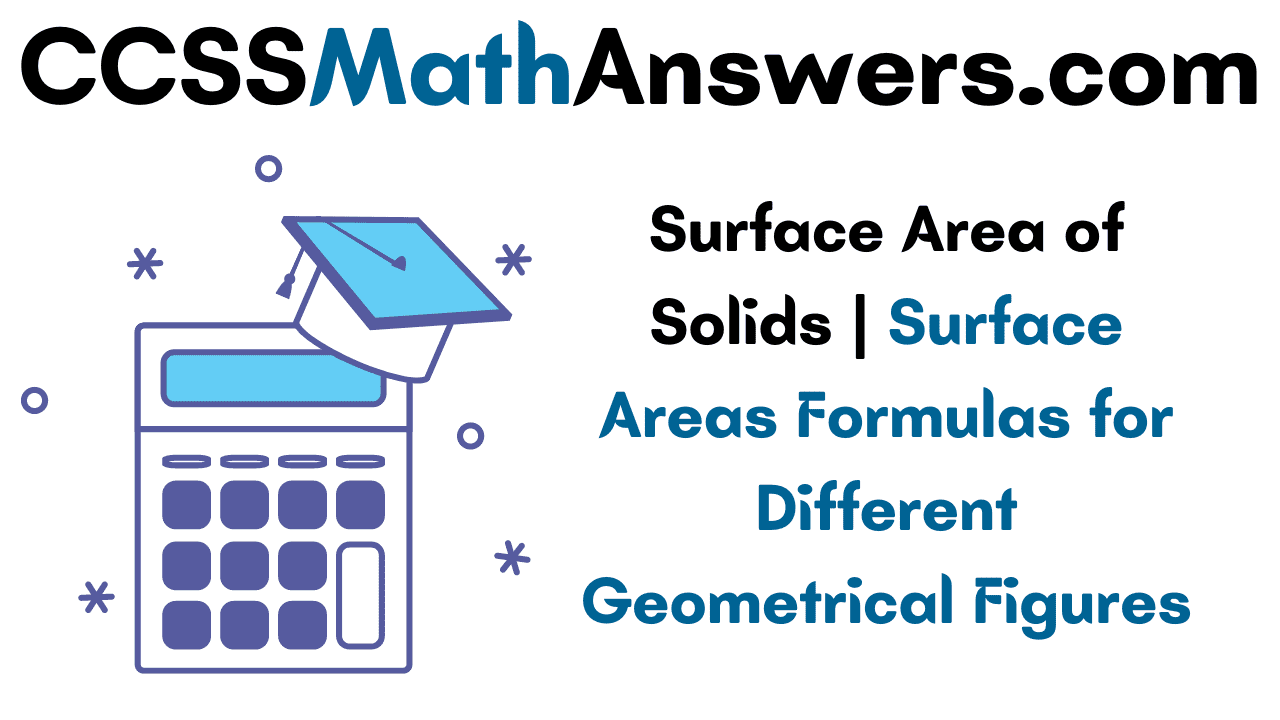Are you confused about the surfaces of solids? You landed on the correct page where you will get plenty of knowledge on the surfaces of solids. This article explains the definition of surfaces of solids, Types of Surfaces, How to find the surfaces of regular solids, surfaces of irregular solids. Check out the regular solids surface area formulas in the later modules.
Do Check:
Surface Area of Solids – Definition
The measurement of the entire area that the surface of the thing occupies of a solid object.
When we check out the shapes, we discover that some are flat and a few are curved. These faces aren’t only seen but also can be touched. This is known as the surfaces of the solids or 3-D figures. Surface area can be measured in square units.
There are two sorts of surfaces: (i) Total surface area and (ii) Curved surface
Total Surface Area
Total surface area means the area including the base and the curved part. It means the total area covered by the surface of the object. If the object has both a curved surface and base, then the total area will be the sum of the two areas.
Curved Surface Area/Lateral Surface Area
The surfaces which aren’t flat, are called curved surface. Curved surface area refers to the area of the curved part of the shape and not it’s base. It is also known as Lateral surface area.
The surface of a ball, or an apple, or orange are examples of curved or maybe a spherical surface. Spherical surfaces are formed by just one surface. We can observe some objects which have both plane and curved sorts of surfaces. For example, drums and clocks are such objects having both flat and curved surfaces.
Regular solids have definite formulas for locating their surface areas. We know the examples of regular solids which include cubes, prisms, cuboids, spheres, hemispheres, cones, and cylinders.
Surface Area of the Regular Solids
Here we will find out the surface areas of the regular solids. We have listed the formulas for finding the surface area of regular solids in the below modules. They are as such
Area of a Solid Cube
The area of a solid cube = 4s2
Where s = length of the side.
Surface Area of a Cuboid
The Cuboid Surface area = 2lw + 2lh + 2wh
SA = 2(lw + lh + wh)
Where, l = length of cuboid, w = width of cuboid, and h = height of the cuboid.
Surface Area of a Solid Prism
A prism may be a three-dimensional solid with two parallel and congruent polygonal bases connected by rectangular faces. The formula for the area for a prism depends on the form of its base.
The general formula for the area of a prism = 2 × area of the bottom + perimeter of base × height.
SA = 2B + ph
Surface Area of a Solid Cylinder
A solid cylinder is an object which has two parallel circular bases and they are joined by a curved surface, at a fixed distance from the center.
The area of a cylinder = 2 × area of circle + area of a rectangle (the curved surface)
The solid cylinder surface area = 2πr (r + h)
Surface Area of a Solid Cone
A cone is solid with a circular base connected to a curved surface that tapers from the bottom to the highest.
The surface area of a solid cone = Area of sector + area of a circle
SA =πrs + πr2 = πr (r + s)
Where s is that the slant height of a cone and r is that the radius of the circular base.
Surface Area of a Solid Pyramid
A pyramid is often defined as a solid with a polygonal base and triangular lateral faces. a bit like a prism, a pyramid is known as after the form of its base.
The general formula for the area of a solid pyramid is:
SA = Base area + ½ ps
Where p = perimeter of and s = slant height of a pyramid.
For, a square pyramid, the, SA = b2 + 2bs
Where, b = base length of the square pyramid and s = slant height of the square pyramid.
Surface Area of a Solid Sphere
The area of a sphere, SA = 4 πr2
For a solid hemisphere, the area, SA = 3πr2
The Surface Area of Irregular Solids
An irregular object may be a combination of two or more regular objects. Therefore, the area of irregular solid is often calculated by adding together the regular objects’ surface areas that form it.
FAQs on the Surface of Solids
1. What is the formula for the total surface area of the cylinder?
The total surface area of the cylinder = 2 π r(r+h), where r is the radius of the circular base and h is the height of the cylinder.
2. What is the Surface area of the cone?
The surface area of a solid cone = Area of sector + area of a circle
SA =πrs + πr2 = πr (r + s)
Wheres is that the slant height of a cone and r is that the radius of the circular base.
3. Find the total surface area of the hemisphere?
The total surface area of the hemisphere is equal to the sum of half of the surface area of the sphere and the area of its circular base.
Total surface area of hemisphere = 2 π r2+ π r2 = 3 π r2
4. What is the area of the prism?
The area of a prism = 2 × area of the bottom + perimeter of base × height.
SA = 2B + ph
